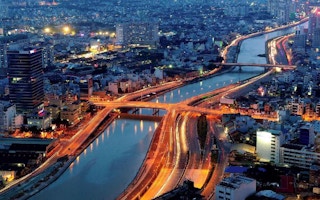The municipal administration plans to reduce and ban exploitation of underground water in phases beginning in 2015, in order to protect its natural water sources and minimise environmental pollution.
A source from the city’s Department of Natural Resources and Environment (DNRE) said the city’s decision had been made in line with a water supply development plan from now to 2025 approved by Prime Minister Nguyen Tan Dung.
The city would mainly use water from available river systems including Dong Nai and Sai Gon, and limit the exploitation of underground water, the source said.
The city would be allowed to tap about 100,000 cubic metres per day from the river systems.
To implement the new plan, the municipal natural resources department will co-operate with the Ministry of Natural Resources and Environment’s Water Sources Planning and Investigation Agency in the Southern Region to draw a map that will identify places where underground water exploitation will be banned or reduced significantly.
From now until 2015, the city will ban exploitation of underground water at 13 old inner-city districts and the Vinh Loc and Tan Tao industrial parks.
Between 2016 and 2020, the city will expand the ban to all remaining districts except 12, Hoc Mon and Cu Chi, and the Tan Binh, Binh Chieu, Linh Trung 1 and 2 industrial parks.
Between 2021 and 2025, the ban will be implemented in District 12 and Tan Thoi Hiep and Tan Phu Trung industrial parks.
Nguyen Hoai Nam, deputy director of the DNRE, said excessive exploitation of underground water in recent years had caused several bad impacts including serious depletion and pollution.
“The city’s ban on the exploitation and use of underground water resources is aimed at protecting the country’s natural resources and encouraging enterprises to use diverse water resources instead,” Nam told the Nguoi Lao Dong newspaper.
“The ban will be carried out in several phases,” Nam said.
Late last week, the natural resources department met with the leadership of industrial parks in the city to inform them about the city’s plan to restrict and stop underground water exploitation.
Nguyen Van Nga, head of the department’s Water Resources Management Division, said at the meeting that according to initial estimates, 48 units in eight industrial parks and export processing zones were licensed by the city administration to exploit 34,270 cubic metres of water per day.
The Vinh Loc, Tan Thoi Hiep, Linh Trung 1 and 2 industrial parks had been granted licences to exploit underground water since they each need more than 3,000 cubic metres a day, but had no other supply source yet, Nga said.
IP representatives at the meeting said they were worried about the city’s decision to ban exploitation of underground water resources. They suggested that the city should just limit, not ban the use of the underground water.
A representative of the Tan Binh Industrial Park said the Sai Gon Water Supply Corporation’s water supply as well as water quality was still unstable.
“Will the company compensate buyers for losses caused by insufficient water supply,” he asked.
Nam said that his department would consider the opinion of water users, and make adjustments to the underground water use plan if deemed necessary.










